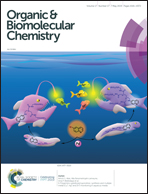Decarboxylative, trienamine mediated cycloaddition for the synthesis of 3,4-dihydrocoumarin derivatives†
Abstract
In this Communication, a new approach for trienamine chemistry is described. It is based on the application of carboxylic-acid-activated dienophiles that undergo spontaneous decarboxylative protonation after the initial [4 + 2]-cycloaddition step. The utilization of such a novel cascade reaction for the synthesis of biologically relevant 3,4-dihydrocoumarins has been demonstrated. High levels of enantiocontrol and excellent yield of the cascade reaction have been achieved by the use of diphenylprolinol diphenylmethylsilyl ether.

- This article is part of the themed collection: Synthetic methodology in OBC


 Please wait while we load your content...
Please wait while we load your content...